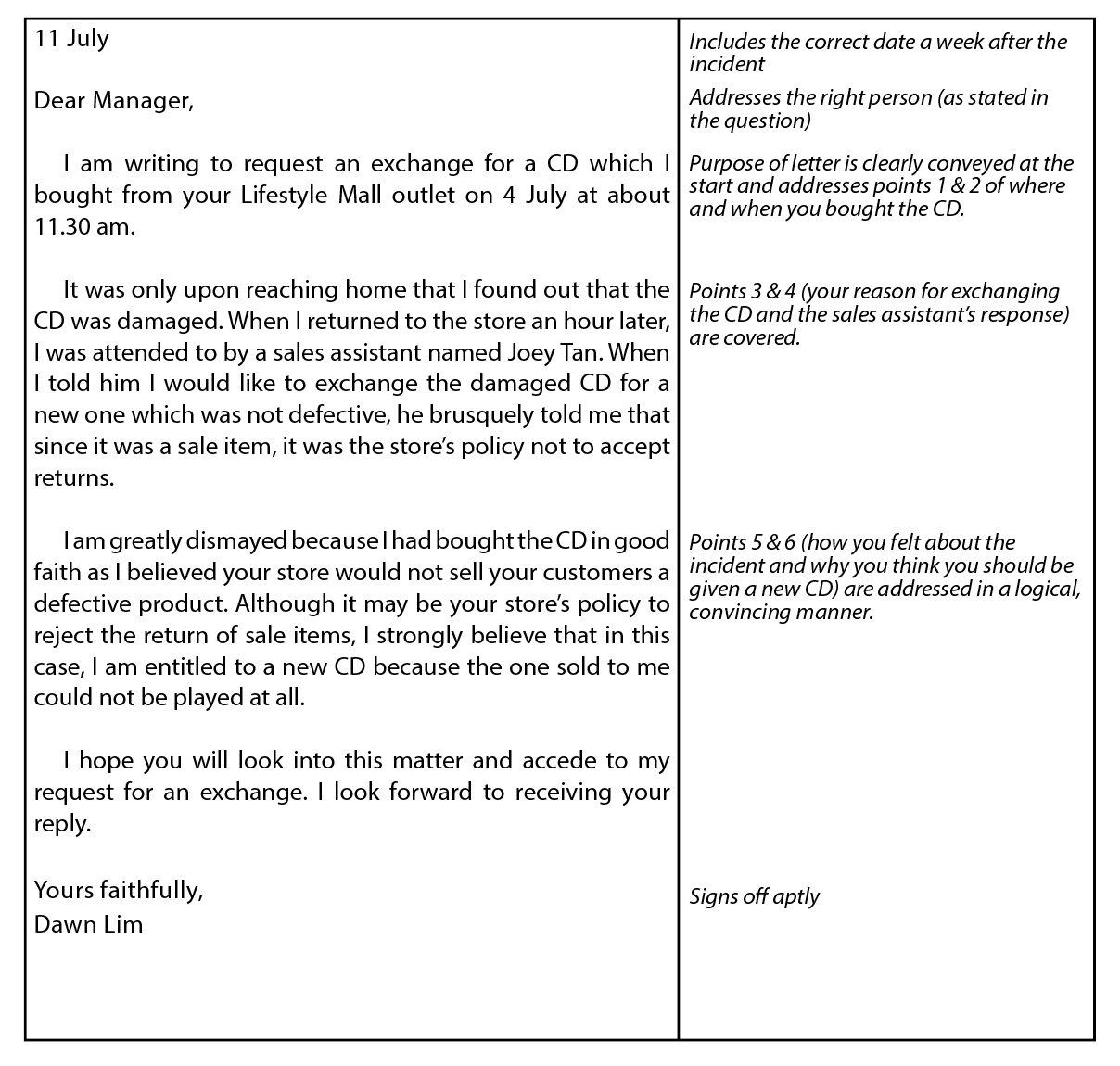
如何在情境写作中拿满分
情境写作是 小六会考(PSLE) 英语考试及小学和中学其他考试的重要组成部分。要拿满分不仅仅需要掌握情境写作的格式,还要精通语言技能并精准完成任务。本指南涵盖正式与非正式写作,提供写作范例和顶尖技巧,将帮助您在情境写作中脱颖而出。
情境写作能拿满分吗?
当然可以!掌握正确的策略,您就能在情境写作中拿满分。关键在于理解评分标准:内容得分为6分,语言得分为9分。
内容(6分)
要在内容上拿满分,考生需要全面完成题目中的所有问题,即涵盖题目要求的所有关键信息。确保处理任务框中的每个细节。考官会寻找特定的内容点,遗漏任何一点都会影响得分。
语言(9分)
此部分关注语法、拼写和标点、句子结构及适当的语气。考试需展示出对英语的扎实的掌握和运用,使表达清晰简洁。
理解情境写作的格式
情境写作主要有两种类型:正式写作和非正式写作,每种格式有不同的风格和目的。
正式写作
正式写作用于专业或官方场合,需要使用礼貌的语气。常见的形式包括:
- 正式信件
- 正式电子邮件
- 报告
正式信件范例

非正式写作
非正式写作用于轻松或私人场合,例如写给朋友或家人,语气较为随意。常见的形式包括:
- 非正式信件
- 非正式电子邮件
非正式信件范例

得满分的技巧
以下是帮助考生在情境写作中拿满分的一些重要技巧:
仔细理解题目问题
考生需仔细阅读任务框和提供的图文材料。理解要求并明确任务的目的、受众和情境,这对准确完成问题至关重要。
使用正确格式
遵循情境写作格式,无论是正式或非正式写作。确保使用适当的结尾词语,如正式信件中的“此致敬礼”和非正式信件中的“您的朋友”。正确的格式体现了您区分不同写作情境的能力。
涵盖所有关键信息
处理题目中提供的所有内容点。遗漏任何关键信息会影响得分。作文需包括所有必要细节,同时避免偏离主题。
使用适当的用语和语气
根据情境调整语气。正式写作使用礼貌用语,非正式写作则较为轻松。用语和语气会影响信息的接受效果。
检查语法错误
确保写作中没有语法、拼写和标点错误。正确的语法对于语言得分至关重要。在提交考卷前需仔细检查,纠正所有错误。
避免不必要的细节
紧扣题目要点,避免添加无关细节。简洁通常比过度描述更有效,能使写作清晰且更好地紧扣主题。
经常练习
定期练习有助于提高写作和语言技能,增强处理不同情境写作的信心。练习越多,对各种写作格式和风格的掌握就会越熟练。
应花多少时间在情境写作上?
在考试中,时间管理至关重要。在小六会考(PSLE)英语考试中,我们建议在情境写作部分花上约15-20分钟,这包括了规划、写作和审阅。
规划:前几分钟要花时间理解问题并计划你的回应。确定需要包含的关键信息,并列出内容要点。这有助于你组织思路,涵盖所有必要的细节。
写作:将大部分时间分配给写作。遵循正确的情境写作格式,涵盖所有必要的要点。全文结构清晰,包括开头、主体和结尾。在适当的地方使用标记符号以增强清晰度和组织性。
检查:留出最后几分钟检查,包括语法和拼写错误,并确保你已写出所有内容要点。检查有助于捕捉到你最初可能遗漏的错误。
正式与非正式情境写作范例
非正式情境写作示例

情境写作中的常见错误
忽略题目要求
一个常见错误是没有仔细阅读题目。开始写作前,请务必理解题目要求。
使用错误的用语
不恰当的用语会严重影响得分。根据题目调整用语和语气——正式场合使用礼貌正式的语气和用语,个人场合则更随意轻松。
句子结构过于复杂
复杂句子容易导致语法错误。简单、清晰的句子更能有效传达信息。避免使用过于复杂的结构,以保持清晰。
遗漏关键信息
未涵盖题目中提到的所有关键信息可能导致失分。确保处理任务框中的每个要点。
未进行检查
跳过检查这个步骤可能导致忽略语法和拼写错误。提交前请务必检查以发现可能的错误。
情境写作中的图文提示
图文提示(如图片或图表)通常用于为情境写作任务提供背景信息,这些图文内容能提供您需要涵盖的关键信息。
有效使用图文提示
观察: 仔细查看图文提示中的所有细节,往往包含写作中所需的关键信息。
与问题链接: Connect the visual stimulus and the task requirements. This helps ensure your response is relevant and complete.
Incorporate Details: Use the information from the visual stimulus to enhance your content. Mentioning specific details from the visual can make your writing more comprehensive.
练习情境写作
定期练习
定期练习对掌握情境写作至关重要。以下是一些策略:
阅读: 通过阅读丰富词汇量和理解能力,这对连续写作和情境写作至关重要。参考情境写作范例,以熟悉不同格式。
多样化题目: 练习各种情境写作题目,包括正式与非正式写作。这有助于熟悉不同格式和情境。
创造性写作: 进行创造性写作练习可以提升学生的批判性思维及表达能力,从而提高情境写作的整体效果。
使用要点: 使用要点可以清晰简洁地组织您的想法。这有助于以结构化的方式呈现所有信息,使读者更容易理解。
限时练习: 通过计时模拟考试环境,有助于在实际考试中有效管理时间。
检查与反馈: 写作后,检查并寻求反馈,识别需要改进的地方并加以改进。
使用往年考卷
使用往年考卷练习非常有帮助。这些考卷让您对可能遇到的题目有更好的了解,帮助提升写作技能。
备考小六会考(PSLE) 情境写作部分
理解评分标准
小六会考(PSLE)情境写作的评分标准详细说明了得分要求。熟悉评分标准有助于了解考官的评分重点。
关键评分要点
回答题目所有要求: 确保涵盖题目的所有方面,包括对图文提示的合理回应和所有内容点的覆盖。
语言和结构: 注意句子结构、语法和写作的整体组织。段落清晰且结构良好的写作得分更高。
目的、受众和情境: 始终考虑您写作的目的、受众和背景。这有助于保持适当的语气和内容。
时间管理
在考试中,合理的时间管理至关重要。以下是建议的步骤:
阅读和规划(5分钟): 仔细阅读问题和图文提示。规划您的答题内容,记录需包括的关键信息。
写作(10-12分钟): 按照正确的情境写作格式撰写内容。
检查(3-5分钟): 检查语法或拼写错误,并确保涵盖所有内容点。
语言能力的重要性
优秀的语言能力是情境写作成功的关键。以下是一些提升语言能力的方法:
阅读: 广泛阅读有助于提升词汇量和对不同写作风格的理解,小说和非小说均有帮助。
写作练习: 定期的写作练习有助于提升语言和写作技巧。尝试不同的情境写作任务,以熟悉各种格式。
口语能力: 口语能力的提升也会促进写作能力的提高。清晰且自信的表达有助于对语言的掌握,并转化为更好的写作能力。
应对情境写作中的常见挑战
理解题目问题: 部分学生可能在正确理解题目问题上感到困难。务必仔细阅读说明,找出需要包含的关键信息。
保持清晰度: 在情境写作中,清晰度非常重要。避免使用过于复杂的句子和专业术语,保持简洁明了。
管理考试压力: 考试压力可能影响表现。练习放松技巧并保持冷静,充足的准备也有助于减轻焦虑。
总结
掌握情境写作的正式写作是理解格式、紧扣题目并具备优秀语言能力的结合。小六会考(PSLE)情境写作考查学生清晰、有效的沟通能力。无论是撰写关于服务问题的投诉信、致校长的正式电邮,还是学校活动的报告,确保主体内容组织良好,易于阅读。使用规范的语法,避免缩写,确保拼写准确。无论是正式还是非正式信件,都应有清晰的目的,并覆盖所有要求的信息。
别忘了正确的落款,检查语法错误。遵循这些提示并定期练习将提高您在考试中取得高分的机会。专注于清晰、相关性和准确性,您一定会表现出色!
如需更多详情和最新信息,请参考 新加坡考试与评估局 (SEAB)。
如你希望在英语作文写作上取得成功,欢迎参加我们的 创意写作课程。
